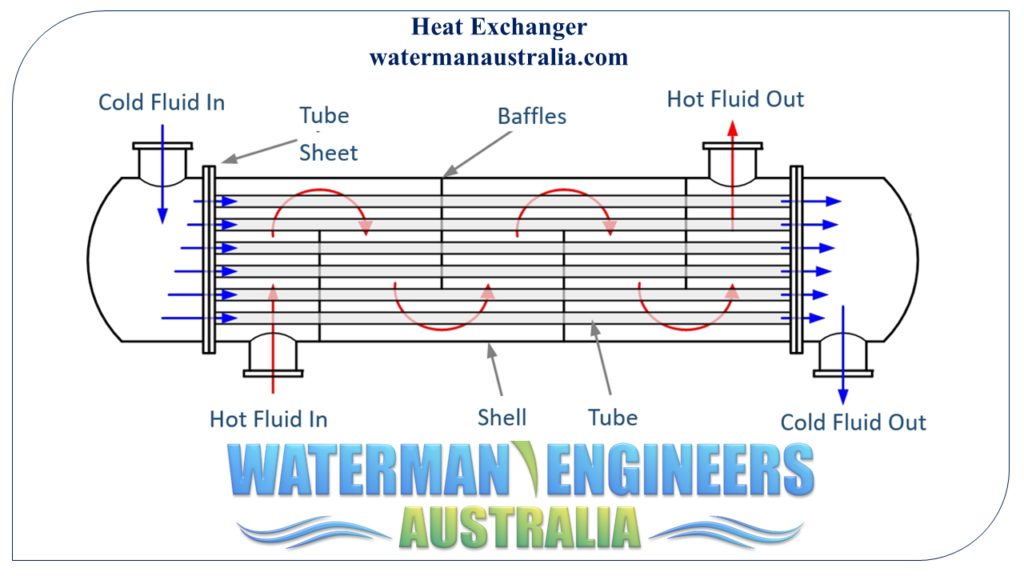
A heat exchanger is a device that allows for the transmission of heat between two different media without any physical contact between them. Heat exchangers work on the idea that thermal energy can be transferred from a hot fluid to a cold fluid. Heat exchangers provide for precise temperature regulation, improving energy efficiency and system functionality by transferring heat between two fluids.
Power plants, chemical plants, HVAC (heating, ventilation, and air conditioning) systems, supermarkets, and many more all employ heat exchangers. They can be found in commonplace home products like air conditioners and water heaters.
In this article, we'll learn about heat exchangers, what they are, how they work, and the different kinds there are. The article also details the common uses and factors to consider when choosing a heat exchanger.
A heat exchanger consists of two flowing fluids divided by a strong wall. Heat is transferred from your incredibly hot fluid on the wall by convection, throughout the wall by conduction and through the wall for the chilly fluid by convection.
Bare tube evaporators are easy, applying one tube to transfer heat. They’re easy to clean and maintain but is often considerably less economical than other styles. You could possibly come across these in older fridges.
The API code and some customer technical specs call for power welds; replacing the tube expansion into grooves + seal weld by combining both equally mechanical strength and leak tightness is often a weaker Answer and isn't recommended.
Along with the Main, the device is made of an insulated container, defrost controls to circumvent moisture freezing over the Main and followers to move the air. All heat exchangers need insulation to raise effectiveness and decrease Designing of heat exchanger manufacturer condensation formation on the surface of the device.
The heat exchanger is a vital part that makes up fuel furnaces. A cracked or damaged heat exchanger can seriously impact your private home’s heating. As fuel burns, it emits toxic fumes like carbon monoxide and its’ the heat exchanger’s career to keep these harmful gases different with the air blown into your own home.
Will not impose seamless tubes, which may Charge additional and possess more time shipping. Welded tubes, which bear a higher degree of non-destructive analysis, are merely as dependable and have a more reliable wall thickness.
Prior to the fuel in the furnace is allowed to burn up, the draft inducer motor switches on. It generates a small vacuum, pushing the poisonous fumes out of your house, in the vent pipe.
Disappointing that there are no layout equations for calculating the areea expected for your specified heat flow.
Ingredient failures in heat exchangers may lead to a complete breakdown of your respective refrigeration procedure. Leads to can include manufacturing defects, put on and tear, or improper upkeep. Typical inspections and proper servicing will help determine and prevent likely failures.
It's two modest steel wires inside of a tube that conducts electric power once they’re heated, sending a signal to your gas valve to allow the gasoline to move. In case the thermocouple doesn't feeling heat through the pilot mild or perhaps the ingredient has long gone poor, it'll shut off the gasoline.
In the event that only among the fluids is fouling, BEM-style with preset tubesheets welded on the shell and straight tubes is considered the most cost-effective. The fouling fluid shall be around the tube facet, that may be mechanically cleaned, as being the tubes are straight.
This article has exactly the same goal for heat exchangers: to make sure that across all disciplines concerned—procedure, heat exchange, and mechanical—by far the most Expense-efficient alternatives are created.
Take note the mechanical design of the heat exchanger shall look at all probable functioning instances. There may be operating situations at reduced turndown the place the thermal enlargement is greater, compared to the design case, resulting from enhanced cooling on the process aspect.
Fundamentals of Heat Exchanger Style is perfect for practising engineers, along with for Superior undergraduate and graduate students in mechanical and aerospace engineering, Electrical power engineering, and associated topics.